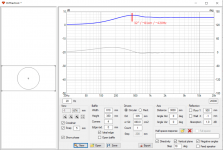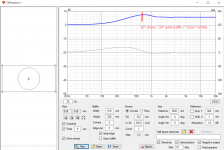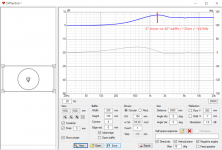How did you make them?These are 2" round corners I have used set to work with 3/4" material. They are easy to use and make for a very still baffle.
Rob 🙂
Why veneer a roundover, or your bevels, as opposed to using solid wood? With a reasonable width, and proper orientation, isn't going to have enough movement to stress joints. Just curious ...
I have worked with a "solid" wood baffle which allowed me to shape and finish the edges without needing to veneer. It was a multi-layered panel made from solid mahogany and plywood.
https://www.diyaudio.com/community/threads/new-active-3-way-hypex-and-sb.352767/#post-6162102
In a later project, I also used the technique of wrapping veneer around a radiused edge. I would say the "solid" multi-layered baffle was more work, but it gave me a lot of flexibility in how I would manage the edge bevels/radii and finishing.
Some people expressed concern that the mahogany-plywood composite panel would self-destruct due to seasonal changes in temperature and humidity. I am happy to report that after two years, there is no degradation.
How did you make them?
I didn't make them don't have the tools for that. You can purchase them. 2,3,4,5 and 6 inches are available as well as different profile choices for joining them to the cabinets.
http://www.aitwood.com/
Rob 🙂
Last edited:
That’s a pretty stark difference. Of course, that’s a 1” disc on what looks like a 6 or 7” [total] width baffle. With a 12” or 15” coaxial driver and hence, much fewer high frequencies “seeing” the baffle edges, I would guess the difference between a chamfer & roundover would drift towards the negligible. Of course, it would be interesting if this was not the case.
I didn't make them don't have the tools for that. You can purchase them. 2,3,4,5 and 6 inches are available as well as different profile choices for joining them to the cabinets.
http://www.aitwood.com/
Rob 🙂
Anyone knowing a European source instead?
Really? What diffraction issues does this guy have?Any true low diffraction cabinet seems to be very labour intensive. Eg. B&W or Vivid cabinet and/or need CNC…
Rounded vs. chamfered edge - sim by @mabat
https://www.diyaudio.com/community/...he-easy-way-ath4.338806/page-477#post-6974283
https://www.diyaudio.com/community/...he-easy-way-ath4.338806/page-477#post-6974283
That takes me to a post on 3D printing.
dave
1 make sure your printer.. 7 different colours...
dave
It works in FireFox, and in Safari, not in iCab, This is the solid format for the post.
https://www.diyaudio.com/community/...-design-the-easy-way-ath4.338806/post-6974283
We had an issue with post link sin the old forum, looks to be back since members couls start choosing posts/page.
dave
https://www.diyaudio.com/community/...-design-the-easy-way-ath4.338806/post-6974283
We had an issue with post link sin the old forum, looks to be back since members couls start choosing posts/page.
dave
The waves in the response are i assume reinforcement & cancelation related to the size of the change at the edges. The chamfer, i’d guess down to the more varies effective radius, has them at lower magnitude.
dave
same as any, problems above frequencies whose wavelenght is shorter than roughly the width of the box. If this is 32" wide it means problems roughly above 400Hz until the woofer beams enough not to disperse sound toward the edge, probably past 1kHz. You can scale it to any size and it works out the same, wavelenght vs. physical size.Really? What diffraction issues does this guy have?
View attachment 1036612
Regarding that sim.. It may seem indicative but it's not definitive.
Is there square corner somewhere?
So are you suggesting that as far as baffles are concerned....the flat parts of the baffle create issues? This makes no sense to me,....Not saying its/you are incorrect I just don't recall anyone ever showing me the "issues".....I thought the only issues came from the edges and the frequencies that interact at the edge and no where else.....and my confusion surround infinite baffle.....Make the baffle infinitely wide and no issues......Make the baffle 32" wide and now the frequencies inside 32" are an "issue"?same as any, problems above frequencies whose wavelenght is shorter than roughly the width of the box. If this is 32" wide it means problems roughly above 400Hz until the woofer beams enough not to disperse sound toward the edge, probably past 1kHz. You can scale it to any size and it works out the same, wavelenght vs. physical size.
Makes no sense to me, at this point.... You would think that the frequencies inside of 32" would response no different than the same spectrum, seeing an infinite baffle.
what is the source of the issues? and what do they look like? @fluid has been trying to teach me but I have yet to see a visualization
Another point....these issues won't be due to edge treatment because the Visualization I have seen show that the frequencies at 32" are so big that they don't care if the edges are treated or not....
Last edited:
There is a difference between a cabinet design that is low diffraction in nature and using a big woofer in a big flat baffle below a frequency where edge diffraction effects will be measurable.Really? What diffraction issues does this guy have?
I'm not trying to say there is an "issue" but there is a difference in the directivity. The width and the depth dimensions of the cabinet work together to dictate the low frequency directivity that the box imparts. Infinite baffles are smooth but they reduce directivity. Not right or wrong just different.what is the source of the issues? and what do they look like? @fluid has been trying to teach me but I have yet to see a visualization
Below 600Hz with a 15" woofer there was no difference in the simulations of edge treatment or square.Another point....these issues won't be due to edge treatment because the Visualization I have seen show that the frequencies at 32" are so big that they don't care if the edges are treated or not....
All these chamfer options and investigations has somehow reminded of those beautiful cabinets from Peak Consult back in the 90s. I really thought they just wanted visual differentiation, with their leather baffles and facetted edges.
I guess part of it are trade secrets; not much is in the public domain. Maybe Olsen from the 1950 to 1960 but then after the 1970s it was mostly veiled because it became financial race...
Looking forward to seeing the results...
I guess part of it are trade secrets; not much is in the public domain. Maybe Olsen from the 1950 to 1960 but then after the 1970s it was mostly veiled because it became financial race...
Looking forward to seeing the results...
For faceted baffles like those you may find some information at this link and the following pages useful
https://www.diyaudio.com/community/threads/a-3-way-design-study.376620/post-6826444
https://www.diyaudio.com/community/threads/a-3-way-design-study.376620/post-6826444
Its all relation between wavelength and the object. All frequencies diffract at an edge they interact, it is just that on a loudspeaker like this highs don't reach the edge as the transducer beams. Low enough lows (bigger than the baffle) just wrap around / diffract enough in phase with direct sound so that not much interference "ripple" is seen in axial response. Only the hump around where wavelength roughly equals baffle width which seems to make constructive interference with direct sound. Above the hump all kinds of ripple show up until the driver beams. This means roughly wavelengths between baffle width and driver diameter would be the ones that produce "ripple" seen in axial frequency response. I have to say there is not much seen here on your example dimensions and with the simple baffle sim, it works out nicely being asymmetric enough spreading the diffraction in time.So are you suggesting that as far as baffles are concerned....the flat parts of the baffle create issues? This makes no sense to me,....Not saying its/you are incorrect I just don't recall anyone ever showing me the "issues".....I thought the only issues came from the edges and the frequencies that interact at the edge and no where else.....and my confusion surround infinite baffle.....Make the baffle infinitely wide and no issues......Make the baffle 32" wide and now the frequencies inside 32" are an "issue"?
Makes no sense to me, at this point.... You would think that the frequencies inside of 32" would response no different than the same spectrum, seeing an infinite baffle.
what is the source of the issues? and what do they look like? @fluid has been trying to teach me but I have yet to see a visualization
Another point....these issues won't be due to edge treatment because the Visualization I have seen show that the frequencies at 32" are so big that they don't care if the edges are treated or not....
Attached is quick demonstration 15" driver on 32" baffle, 10" driver on 20" baffle and 5" driver on 10" baffle. Although, as seen from mabats full box sims these simple baffle only sims don't tell the full story how a box performs diffraction wise. What these show that there is wavelength in the math, which I suppose is based on reality. Cycle through the attachments and see how the features of the interference on the axial response are exactly the same on all of these examples, only difference you notice is that the response features shift up in frequency as the transducer and baffle gets smaller. So yeah your example big box diffracts the same as would 5" on ~10" baffle, only at lower bandwidth. Just don't use the box up to the diffracting bandwidth and you are golden without roundovers. As you narrow the baffle, the diffraction happens at higher frequency, hence max usable bandwidth below diffraction comes with as narrow baffle as possible, from baffle step down (with square edge). You'll lose the baffle support though, it is compromise where you slide the baffle step down in frequency by widening baffle but slide much past the driver width and diffraction drags down with it and creeps into the bandwidth, you can easily test this on a baffle diffraction simulator. No problem if you crossover below this, about at the baffle step.
Perhaps more importantly there is the time aspect that is not so obvious in the frequency response plot but can be visualized in ripple tank simulator for example, path length along the baffle just "smears" the direct sound. Diffraction creates another sound source along the baffle edge with varying time / phase depending on distance from transducer to edge, this is what creates diffraction interference pattern seen in frequency response / polar plots and perhaps works similarly as shading on a line source, manipulates the pattern. We should definitely take advantage of this effect, this is something mabat's recently posted series of sims show, definitely something that is not talked about mucho in the forum other than perhaps fluid who has done similar simulations himself. Anyway, the smaller the baffle the less time delay from transducer to edge. With big enough baffle this could be count in milliseconds. If there is no baffle the situation is as good as it gets, delay would be about the same as with naked transducer which you cannot better / do nothing about because there has to be one, with some physical size. The other way is to make infinite baffle, or infinite enough, where there is no edge to interact with within certain amount of milliseconds. We gotta remember in a room there are many objects the sound diffracts and we need to fit the speakers into the room. In-wall is closest thing to infinite baffle. There is some rules of thumb that speakers sound better so and so much away from any walls, to delay the first early reflections. Baffle edge creates the earliest one so there is good reason to mind about it, either make it very short delay by narrowing the baffle and crossing over before diffraction, or very long, or try and mitigate with big enough round overs.
ps. thinking of it, hearing system is very good at removing reflections from perception, it hears the direct sound quite clearly even if we have million reflections going on in the room at the same time. If we assume early reflections from room walls should sound the same as direct sound (constant directivity) in order to make best audio experience so in that sense if baffle diffraction sounds uniform it would also be ignored by the hearing system, integrate the ways of a multi-way speaker as one? All ways of multi-way speaker should share common similar diffraction signature in order to blend as one, delay to edge? Perhaps hearing system doesn't work like so... or perhaps MEH / fullrange / coaxial / coincident systems have good following because of this uniform diffraction response across all transducers, along with having same delay from all transducers to all room boundaries as well, making all the early reflections including diffraction easy for brain to filter out. Going of topic, but writing helps thinking so went with it. Carry on 🙂
Attachments
Last edited:
- Home
- Loudspeakers
- Multi-Way
- Roundover vs. 45º Chamfer vs. Double 22.5º Chamfer edge treatments for tweeter diffraction.


